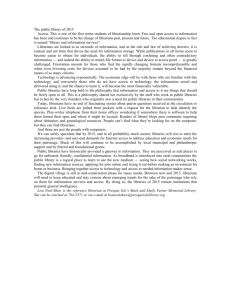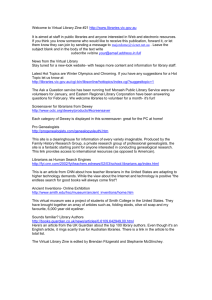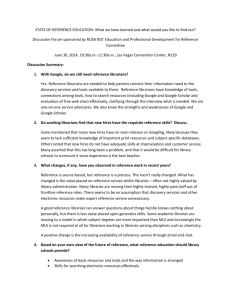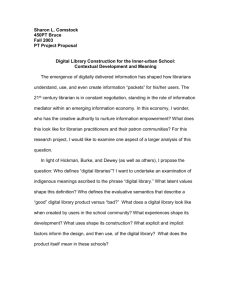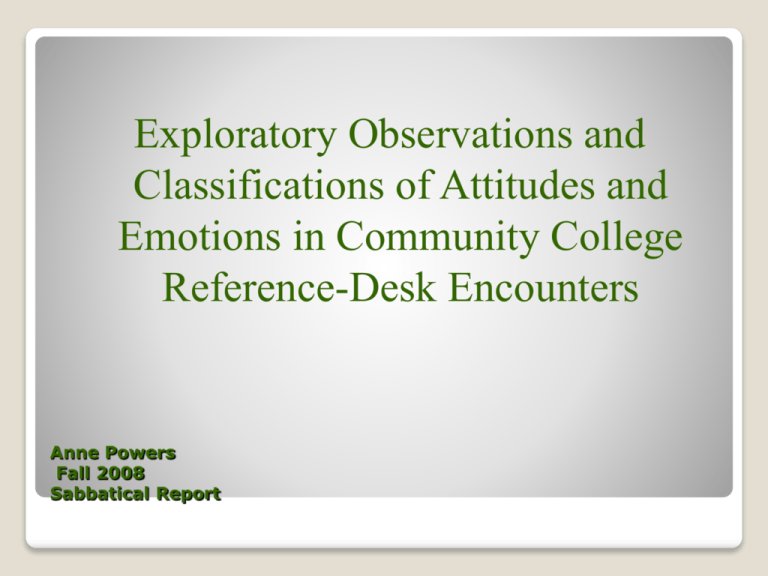
Exploratory Observations and
Classifications of Attitudes and
Emotions in Community College
Reference-Desk Encounters
Anne Powers
Fall 2008
Sabbatical Report
The following presentation is a report based on projects of my Fall 2008
Sabbatical: observation of reference desk service at area academic libraries for
comparison and contrast with my experience of reference-desk service at SMC
Library. This report centers on my observations of students; a second report
deals with a survey of the feelings of reference librarians in California
community colleges.
The focus of my observations and studies was the affective side of reference
delivery and reception; important aspects that have implications for library
service since 1986, when Constance Mellon addressed the fact that many more
library users than supposed approached librarians at reference desks with a
trepidation that she articulated for the first time in the term “library anxiety”.
Since that time, many studies and commentaries have arisen which treat the
topic, but none that adequately, to my mind, addressed the feelings of
community college students. My observations focused on the feelings of
students (and librarians, to a secondary degree) as I subjectively categorized
them. This was a valid approach, since that is what each reference librarian
has to do in each encounter with each individual who approaches for service at
the desk: gauge the attitudes as well as encompass the information need.
Experience has shown that, in order to provide good reference service, the
affective as well as cognitive and behavioral aspects of the transactions are
very often interdependent on one another for successful conclusion of
reference encounters. (continued)
FOREWORD
The college libraries to which I made multiple visits during September-December
2008, and my primary contacts, included:
West Los Angeles College: Judy Chow, Department Chair
Glendale College: Brenda Jones, Reference Director
Pasadena City College: Dona Itoma, reference Liaison
UCLA College Library: Debe Costa and Esther Grassian, Reference Liaisons
UCLA Young Research Library: Sarah Watstein, Director of Reference services
The community colleges chosen for visits were selected for their similarity to SMC
client base. The UCLA sites were chosen because the university is one of the
major institutions to which many SMC students transfer; this was an
opportunity to observe what preparation was expected of students in UCLA
libraries.
The practical object of my observations was to learn, from current interactions
between librarians and students at different institutions, about what I could
take from the experience to inform improvement of student success through
library reference service at my own institution. My observations and
conclusions have been shared with my department and Iwill be included in my
discussions with fellow reference librarians about how we can better serve our
students.
AP
FOREWORD
continued
Exploratory Observations and Classifications of Attitudes and Emotions
in Community College Reference-Desk Encounters
Research Objectives:
to observe and classify types of
affect/attitudes/emotions
shown by information seekers and providers
at the beginnings and conclusions of reference-desk
encounters
in Southern California community college libraries
How do information seekers feel, at the
beginnings of the interactions, when seeking help
from community college reference librarians?
How do they feel at the conclusions of the
encounters?
Secondarily, how do community college reference
librarians feel, at the beginnings of the
interactions, when providing help requested by
information seekers?
How do they feel at the conclusions of the
encounters?
Research Questions
A total of twelve visits between October and
November 2008 were made to libraries where
observations took place.
Visits took place, by prearrangement, at various
times between the morning and evening to allow
for a variety of patrons.
Visits occurred on all days of the week except
Sunday.
Observation sessions ranged from a minimum of
two hours to a maximum of four hours.
Encounters which met criteria for inclusion were
analyzed and interpreted.
Method
Method
continued
The observation method used was exploratory realtime examination of patron and librarian interaction
at Los Angeles area community college libraries.
The colleges were selected for similar libraries,
librarian personnel, and student-body makeup.
The study is based entirely on observation.
Observation sessions were arranged beforehand.
Observations took place at active reference desks,
with observer seated with the library’s regularly
scheduled reference librarians.
Observed patrons self-selected for approach to the
desks.
A valid encounter, for purposes of the
study, was defined as:
the eliciting of information, help with
research, etc., by a randomly selfselecting, self-initiating library user
from a librarian stationed at the reference
desk,
which led to interaction between the
library user and the librarian,
and resulted in an outcome.
Definition of “Encounters”
All who approached the desk with a query
were observed.
No overt attempt was made to determine if
patrons were students, faculty members,
staff employees, or community patrons; the
patrons self-disclosed their status.
No attempt was made to filter for any specific
group or type of patron, except for subjective
demographic analysis:
All designations of age, ethnicity, etc. were
based on the researcher’s observations and
conclusions only.
Characteristics of Observed Patrons
Patron Demographics: Gender
GENDER
NUMBER of
PATRONS
%
M= MALE
33
49
F=FEMALE
34
51
Totals
67
100
Patron Demographics: Age
AGE
NUMBER of
PATRONS
%
18-25
47
32
26-35
5
14
36-49
7
26
50-59
6
19
60+
2
9
Totals
67
100
Patron Demographics: Ethnicity
ETHNICITY
NUMBER of
PATRONS
%
Caucasian
25
38
African American
18
28
Asian Americans
7
10
Hispanic American
5
7
Mideastern
5
7
Armenian
4
6
Hispanic/Latino/a
1
1
Asian
2
3
Totals
67
100
Patron Demographics:
Language Ability
ENGLISH
LANGUAGE
ABILITY
Native Speakers of
English=E
English
Learners=EL
Totals
NUMBER of
PATRONS
%
50
75
17
25
67
100
Librarians on duty at the reference desks
during the observations included adjunct and
fulltime personnel.
Male and female librarians were observed.
All librarians were professionals with MLS
degrees.
Most were reference librarians only or
combined reference with instruction duties.
Two of the librarians had cataloging as well
as reference duties.
Characteristics of Reference-Desk Librarians
Reference area.
Arced reference
desk where two
librarians are usually
on duty during
daytime hours.
Circulation desk at
entrance/exit.
Signage directs or
advises.
GCC LIBRARY Reference area.
View from upper level.
Reference area:
Includes reference
desk with ready
reference shelves,
small seating areas
and display shelves.
Eighty workstations
in computer lab,
served by
“uniformed” student
assistant.
Circulation desk at
entrance/exit at
right of reference
desk.
WLACC LIBRARY
View from upper level
Each valid encounter occurring during
observation was logged in a journal.
Each entry contained notations of age,
ethnicity, and gender of each information
seeker.
Each entry noted the type of query.
The “emotion” of each participant was
noted.
Librarians’ “emotions” were also classified.
Observation Procedures
The categories into which the researcher placed
information seekers were the results of subjective,
though educated, conclusions.
This small study was undertaken to test whether
larger, more empirically-structured investigation was
warranted.
The sampling is too small for extrapolating true
generalizations.
No appreciable inclusion of formal concepts such as
Information Literacy or Web 2.0 models were
considered for this study.
Focus of the observations centered only on
interpreting the one-time transactions at the
reference desk.
Scope and Limitations
The sampling is too small for true generalizing in
regard to community-college library reference
service; however, results show that a larger, more
structured study is indicated.
The results provide valuable pointers for further
investigation of more user-centered future models of
planning, preparing for, and delivering reference
service in community college libraries.
Future studies should include analysis of how
demographics affect study results.
The results justify further, more formal investigation,
with primary attention to the effects of burgeoning
technology on the attitudes and approaches to
information seeking and providing in community
college libraries.
Recommendations for Further Research and Study
Research Data:
Categories, Numbers, and Percentages
Illustrated by Tables and Charts
Results
The affects noted for each group fell into
three main categories, as applicable:
Positive
Neutral
Negative
These values were categorized separately
for the beginnings of each interaction and
ends of each interactions for each group.
Main Categories of
Emotions/Attitudes
Two groups were observed, and their
attitudes categorized:
Information seekers (students, staff,
community patrons)
Information providers (librarians)
Analysis
Positive: Confident/Expectant (hopeful)
Negative: Wary (doubtful)/Anxious
Classifications of Affect Manifested by Information
Seekers at Beginning of Encounter
Information Seekers’ Attitudes at Beginning of
Reference Desk Encounters
A. HOW INFORMATION SEEKERS FELT AT BEGINNING OF REFERENCEDESK ENCOUNTER
WARY
CONFIDENT
22%
18%
EXPECTANT
12%
ANXIOUS
48%
CONFIDENT
EXPECTANT
ANXIOUS
WARY
Information Seekers’ Attitudes at Beginning of
Reference Desk Encounters
B . P OS I TI VE VS N EGA TI VE A TTI TU D ES OF I N FOR M A TI ON S EEK ER S A T B EGI N N I N G OF
R EFER EN C E EN C OU N TER
P OSI T I V E (CONFI DE NT +
E X P E CT A NT )
30%
NE GA T I V E (A NX I OUS +WA RY )
70%
P OSI T I V E (CONFI DE NT +E X P E CT A NT )
NE GA T I V E (A NX I OUS +WA RY )
Positive: Satisfied
Neutral: Limbo
Negative: Unsatisfied
Classifications of Affect Manifested by
Information Seekers at Close of Encounter
Information Seekers’ Attitudes at Conclusion
of Reference Desk Encounters
ATTITUDE OF INFORMATION SEEKER AFTER CONCLUSION OF REFERENCE-DESK ENCOUNTER
UNSATISFIED
9%
LIMBO
18%
SATISFIED
LIMBO
UNSATISFIED
SATISFIED
73%
Positive : Welcoming
Neutral: Neutral
Negative: Remote
Classifications of Affect Manifested by
Information Providers at Beginning of
Encounter
Information Providers’ Attitudes at Beginning
of Reference Desk Encounters
ATTITUDES OF LIBRARIANS AT BEGINNING OF REFERENCE-DESK ENCOUNTERS
REMOTE
3%
WELCOMING
31%
NEUTRAL
WELCOMING
REMOTE
NEUTRAL
66%
Positive : Satisfied
Negative: Dissatisfied
Classifications of Affect Manifested by
Information Providers at Close of Encounter
Information Providers’ Attitudes at Conclusion
of Reference Desk Encounters
ATTITUDE OF LIBRARIAN AFTER CONCLUSION OF REFERENCE-DESK ENCOUNTER
DISSATISFIED
7%
SATISFIED
93%
The affective “tone” of interactions
between library users and librarians in
community college library reference-desk
encounters should be taken into account
to provide better service.
The affective tone of interactions
between library users and librarians in
community college library reference-desk
encounters should be taken into account
to lessen library anxiety.
Conclusions
The principal value of the project was the
opportunity to absorb the information seeker’s
point of view.
The principal lesson was that the gap needs to be
bridged between information patrons’ and
information professionals’ expectations of each
other.
Community college librarians should be leaders
in crafting the solutions to communications
problems between information providers and
seekers.
Conclusions
continued
Attitude and emotion are
“unacknowledged” but large parts of
information-seeking interaction between
users and providers in libraries.
Although this aspect of librarianship is not
particularly neglected in the literature, it
is neglected in practice.
Conclusions
continued
Bostick, S. L. (1992). The development and validation of the library
anxiety scale. PhD Thesis. Michigan: Wayne State University.
Boyd, E., & Iovino, A. (2008, Spring). Library 2.0: The next generation
of librarians. Mississippi Libraries 72 (1), 11-13. Retrieved October 27,
2008, from Library Literature & Information Science Full Text database.
Buckland, M. K. (2008). Reference library service in the digital
environment. Library & Information Science Research (30), 81-85.
doi:10.1016/j.lisr.2008.03.002
Buckner, T., & French, T. (2007, Spring). International students and
the academic library: how one library is working to make its international
students feel at home. Kentucky Libraries 71 (2), 8-11. Retrieved October
27, 2008, from Library Literature & Information Science Full Text
database.
Case, D. O. (2008). Looking for information: A survey of research on
information seeking, needs, and behavior. 2d Ed. United Kingdom:
Emerald Group.
Bibliography
Cruger Dale, D. (1977, May). Questions of concern: Library services to
community college students. Journal of Academic Librarianship, 3 (2), 8184. Retrieved November 8, 2008, from Professional Development
Collection database.
Dervin, B., & Foreman-Wernet, L. Eds. (2003). Sense-making
methodology reader: Selected writings of Brenda Dervin. Cresskill, NJ:
Hampton Press.
Jiao, Q. G., Onwuegbuzie, A. J., & Lichtenstein, A. A. (1996, Spring).
Library anxiety: Characteristics of at-risk college students. Library and
Information Science Research 18 (2), 151-163.
Knibbe-Haanstra, M. (2008, Fall 2008). Reference desk dilemmas: The
impact of new demands on librarianship. Reference & User Services
Quarterly, 48 (1), 20-25. Retrieved November 4, 2008, from MasterFILE
Premier database.
Kuhlthau, C. C. (1988). Developing a model of the library search
process: cognitive and affective aspects. Reference & User Services
Quarterly 28 (2), 232-242.
Mellon, C. (1986). Library anxiety: A grounded theory and its
development. College and Research Libraries 47 (2), 160-165.
Bibliography
continued
Metzger, R. (2008, November 15). Embracing my authority. Library
Journal, 133(19), 37-37. Retrieved November 4, 2008, from MasterFILE
Premier database.
Murley, D. (2008, Winter). What is all the fuss about Library 2.0? Law
Library Journal 100 (1), 197-204.
Singh, J. (2008, March). Sense-making: Information literacy for lifelong
learning and knowledge management. DESIDOC Journal of Library &
Information Technology 28 (2), 13-17.
Sonntag, G., & Palsson, F. (2007). No longer the sacred cow no longer
a desk: Transforming reference service to meet 21st century user needs.
Library Philosophy and Practice 2007. Retrieved from
http://www.webpages.uidaho.edu/~mbolin/sonntag-palsson.htm
Weiler, A. (2001). Two-year college freshmen and the Internet: Do they
really “know all that stuff?”. Libraries and the Academy 1 (2), 161-167.
Retrieved October 27, 2008, from Library Literature & Information Science
Full Text database.
Weiler, A. (2005, January). Information-seeking behavior in Generation Y
students: motivation, critical thinking, and learning theory. The Journal of
Academic Librarianship 31 (1), 46-53.
Bibliography
continued
Selected Images
Addenda
The Library
signage made it
clear what uses the
computers could be
put to.
There were other
workstations for
catalog searching
only, and on the
upper level several
computers offered
students e-mail
access.
GCC Library: Close-Up of Computer Signage
Student carrels on the
entry level floor of the
library ensure privacy
of each student.
Computer work
stations were
available in many of
the carrels.
Group study rooms
were also available on
the entry level floor.
Student Carrels in GCC Library
A more
detailed view of
a carrel that
contains a
student-use
computer, with
signage
designating the
computer’s
uses.
GCC Library Student Carrels
GCC Library
Rack of student
guides– such as how
to use MLA, how to
search databases, etc.
Their home page also
has links to such
student helps.
The printer sign
points out the one
printer on the entry
floor level.
GCC Library: Guides for Students
Another example of
the use of signage in
the GCC Library.
Different banks of
computers were used
for different
purposes– some
computers on the
lower level, like this
one, were dedicated
to one purpose, such
as searching the
catalog.
GCC Library Posting of Computer Usage
Rules on Screens of Student-Use
Computers
The data in this presentation is for
information only. All information
presented subject to change and/or
correction.
All rights reserved.
Copyright © 2008, 2009
Disclaimer

